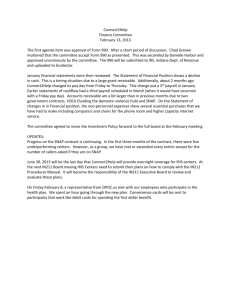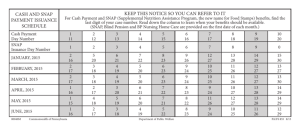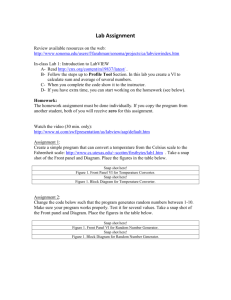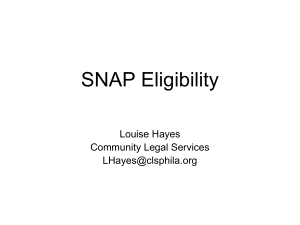The Farm Bill 101 - No Kid Hungry Playbook
advertisement
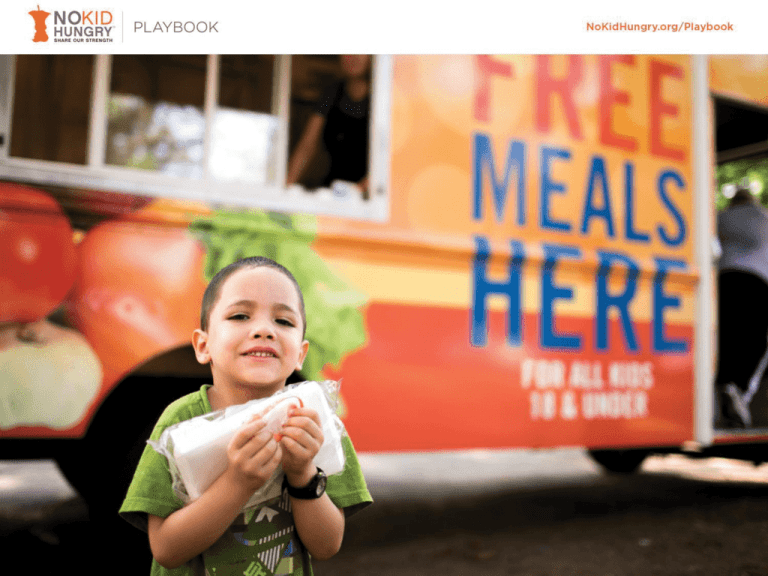
1030 15th Street NW, Suite 1100 NW, Washington, DC 20005 | 5/8/2015 | Page 1 THE FARM BILL 101 1030 15th Street NW, Suite 1100 NW, Washington, DC 20005 | 5/8/2015 | Page 2 WHAT IS THE FARM BILL? • Legislation that directs agriculture and nutrition spending and policy. • Reauthorized by Congress every five years. The most recent bill was signed into law in February 2014. • Provides authorization for SNAP and SNAP-Ed. • Under the jurisdiction of the Senate Agriculture Committee and House Agriculture Committee in Congress. 1030 15th Street NW, Suite 1100 NW, Washington, DC 20005 | 5/8/2015 | Page 3 SNAP (SUPPLEMENTAL NUTRITION ASSISTANCE PROGRAM) SNAP is our largest and most powerful anti-hunger program for children and families. Approximately 46 million Americans participate in SNAP each month, with about half of those being children. The average monthly SNAP benefit for a household with children was $413 per month in 2011. Eligibility for SNAP is determined by income levels and asset tests. SNAP is administered at the state level and states have the ability to adjust certain policies as they see The overall structure and funding levels for SNAP are set by the federal government. Learn more about how SNAP works in your state by visiting the State SNAP Toolbox. 1030 15th Street NW, Suite 1100 NW, Washington, DC 20005 | 5/8/2015 | Page 4 SNAP-ED SNAP-Ed provides funding to states for nutrition education programming with the goal of: Improving the likelihood that persons eligible for SNAP will make healthy food choices within a limited bud and choose physically active lifestyles consistent with the current Dietary Guidelines for Americans and MyPlate.1 The programs are carried out by community and state-based organizations, to teach skills such as: • • • • Comparing unit prices to maximize food budgets. Reading food labels. Finding whole grain foods. Differences between fresh, frozen, and canned produce. Nutrition education shows effective results in: • • • Increasing fruit and vegetable consumption. Reductions in rates of childhood obesity. Healthy, low-budget meal planning. SNAP-Ed is available to individuals receiving assistance through programs such as SNAP, the Special Supplemental Program for Women, Infants and Children (WIC), and Head Start. Share Our Strength’s Cooking Matters program empowers low-income families with the skills and tools shop for and prepare healthy food on a budget • • Since 1993, more than 150,000 low-income families have been reached through Cooking Matters. We partner with local non-profits to offer six-week free cooking courses and grocery store tours. 1030 15th Street NW, Suite 1100 NW, Washington, DC 20005 | 5/8/2015 | Page 5 HOW THE FARM BILL BECOMES LAW COMMITTEES FULL HOUSE & SENATE • House Agriculture Committee and Senate Agriculture Committee draft separate bills. • Committee bills go to full House and Senate -- assuming passage out of Committees. • Committees hold hearings on programs in the legislation. • Amendments offered to bills. • Committees vote on bills. • Full House and Senate vote on bills. CONFERENCE COMMITTEE • Selected Conference Committee members to merge House and Senate bills. • Final bill sent to House and Senate floor for passage. 1030 15th Street NW, Suite 1100 NW, Washington, DC 20005 | 5/8/2015 | Page 6 PRESIDENT • President signs or vetoes legislation. THE FARM BILL OF 2014 1030 15th Street NW, Suite 1100 NW, Washington, DC 20005 | 5/8/2015 | Page 7 SNAP AND SNAP-ED CHANGES IN THE FARM BILL OF 2014 Adjusts the “Heat and Eat” provision of the bill to require households enrolled in the Low Income Home Energy Assistance Program (LIHEAP) to receive at least $20 in benefits to qualify for additional food aid This adjustment will impact approximately 850,000 households, lowering SNAP benefits by $90 a month Includes a pilot project to test strategies to increase employment for SNAP recipients. Includes measures to improve the program integrity of SNAP. Holds SNAP-Ed funding at current levels. The final bill will save an estimated $8.55 billion over the fiscal years 2014 to 2023. Learn more about how the Farm Bill of 2014 impacts SNAP and SNAP-Ed at Center for Budget and Policy Priorities. 1030 15th Street NW, Suite 1100 NW, Washington, DC 20005 | 5/8/2015 | Page 8
